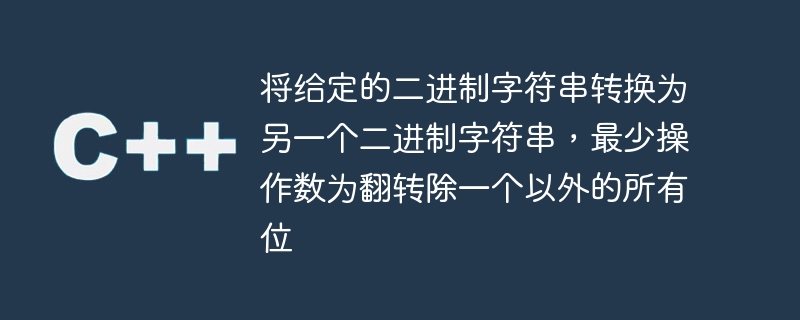
在这个问题中,我们需要通过翻转字符串的字符,将一个二进制字符串转换为另一个二进制字符串。我们可以保存任何设置的位并翻转其他位,并且我们需要计算总操作以通过这样做来实现另一个字符串。
我们可以根据给定字符串中“01”和“10”对的总数来解决问题。
问题陈述- 我们给出了两个长度相同的字符串,分别名为 str1 和 str2,包含“0”和“1”字符,表示二进制字符串。我们需要通过执行以下操作将字符串 str1 转换为 str2。
我们可以选择任何设置的位并翻转所有其他位。翻转位意味着将“0”转换为“1”,将“1”转换为“0”。
如果无法将 str1 转换为 str2,则打印 -1。
示例
输入
'str1 = "001001111", str2 = "011111000";
输出
'3
解释−
在第一个操作中,我们保持第二个索引的“1”不变,并翻转 str1 中的所有其他字符。因此,str1 将是 111110000。
在第二个操作中,我们保持第 0 个索引的“1”不变,并翻转所有其他字符。因此,str1 将是 100001111。
在最后一个操作中,我们将“1”保存在第 5 个索引处。因此,str1 将变为 011111000。
输入
' str1 = "0000", str2 = "1111";
输出
'-1
解释- 无法将 str1 转换为 str2,因为 str1 不包含任何要保存的“1”字符。
输入
' str1 = "0111", str2 = "1000";
输出
'-1
说明- 无法将 str1 转换为 str2。
方法 1
我们可以通过观察来解决问题。观察结果是,当我们持有任何单个设置位并执行 2 个操作时,我们可以获得相同的字符串。因此,我们需要选择不同的1索引来对字符串进行更改。
此外,我们需要执行 2 次操作才能将 01 对转换为 10。例如,将“1”保留在“01”中。所以,我们得到“11”。之后,将“1”保留在“11”中的第 0 个索引处,这样我们就会得到“10”。
要得到答案,01 ( 0 -> str1, 1 -> str2) 和 10 ( 1 -> str1, 0 -> str2) 应该是相同的。否则,我们可以说答案不存在。
我们的主要目标是最小化“01”和“10”对,因为我们可以通过 2 次操作将“01”转换为“10”。
算法
第 1 步- 定义totalOperatrions() 函数来计算将str1 转换为str2 所需的操作数。
步骤 1.2 - 初始化 count10 和 count01 变量以将“01”和“10”对存储在字符串中。
步骤 1.3 - 遍历字符串并计算两个字符串中的 01 和 10 对。
步骤 1.4− 如果 count10 和 count01 相同,则返回 2*count10。否则返回-1。
第 2 步- 定义minimumOperations() 函数来计算将 str1 转换为 str2 所需的最少操作。
第 3 步- 用最大值初始化“ans”。
第 4 步- 使用原始字符串调用totalOperations() 函数,并将结果存储在“operation1”变量中。如果返回值不等于-1,则将ans和操作1中的最小值存储在ans中。
第 5 步- 现在,我们将修改字符串以最小化 01 和 10 对。因此,定义 stringModification() 函数。
步骤 5.1 - 在函数中,我们找到字符串中的第一对“1ch”,并将“ch”作为参数传递,可以是“0”或“1”。因此,该对应该类似于 1 -> str1 和 ch -> str。
步骤 5.2- 如果未找到“1ch”对,则返回 false。
步骤 5.3 − 如果找到“1ch”对,则保持该对不变并翻转 str1 的其他字符。
第 6 步- 执行 stringModification 函数以保持“11”对不变并翻转其他字符。之后,再次调用totalOperations()函数来查找将str1转换为str2所需的操作。
第 7 步− 如果操作 2 不等于 -1,则将“ans”或“1 + 操作 2”中的最小值存储在“ans”中。这里,我们添加了 1,因为我们使用了一次操作修改了字符串。
第 8 步- 通过保持第一个“10”对不变来修改字符串,并计算操作数。再次为“ans”分配最小值。
步骤 9− 如果“ans”等于 INT_MAX,则返回 −1。否则,返回 ans。
示例
'#include <bits/stdc++.h>
using namespace std;
// counting 01 and 10 pairs
int totalOperations(string str1, string str2) {
int len = str1.size();
int count10 = 0, count01 = 0;
for (int p = 0; p < len; p++) {
// If characters at p index are not same
if (str1[p] != str2[p]) {
// Increase count01 if 0(str1)-1(str2), else count10 if 1(str1)-0(str2)
if (str1[p] == '0')
count01++;
else
count10++;
}
}
// If we have euqal number of 01 and 10 pairs, we need 2 operations to flip one pair.
if (count01 == count10)
return 2 * count01;
return -1;
}
bool StringModification(string &temp1, string &temp2, char ch) {
int len = temp1.size();
int index = -1;
// Find the pair of 1c character. (1 -> temp1, c -> temp2)
for (int p = 0; p < len; p++) {
if (temp1[p] == '1' && temp2[p] == ch) {
index = p;
break;
}
}
// return 0 if pair is not found
if (index == -1)
return false;
// Flip other characters in both strings
for (int p = 0; p < len; p++) {
if (p != index) {
if (temp1[p] == '1')
temp1[p] = '0';
else
temp1[p] = '1';
}
}
return true;
}
// finding minimum operations
int minimumOperations(string str1, string str2) {
int ans = INT_MAX;
// first case with initial strings
int operation1 = totalOperations(str1, str2);
if (operation1 != -1)
ans = min(ans, operation1);
string temp1 = str1, temp2 = str2;
// Case 2, modification for 11 pair
if (StringModification(temp1, temp2, '1')) {
// get operations after modification
int operation2 = totalOperations(temp1, temp2);
// adding 1 to operation2 as we have done one modification initially
if (operation2 != -1)
ans = min(ans, 1 + operation2);
}
// Case 3 modification for 10 pair
temp1 = str1, temp2 = str2;
if (StringModification(temp1, temp2, '0')) {
int operation3 = totalOperations(temp1, temp2);
if (operation3 != -1)
ans = min(ans, 1 + operation3);
}
if (ans == INT_MAX)
return -1;
else
return ans;
}
int main() {
string str1 = "001001111";
string str2 = "011111000";
int ans = minimumOperations(str1, str2);
if (ans == -1){
cout << "S1 to S2 conversion is not possible";
}
else{
cout << "Minimum number of operations required are: " << ans << "n";
}
return 0;
}
输出
'Minimum number of operations required are: 3
时间复杂度− O(N),因为我们在 stringModification() 和totalOperations() 函数中遍历字符串。
空间复杂度− O(1),因为我们修改相同的字符串而不使用任何额外的空间。
在代码中,我们的主要目的是在修改字符串后,减少给定字符串中01和10对的数量,以尽量减少操作。程序员可以使用各种输入并尝试理解答案。



